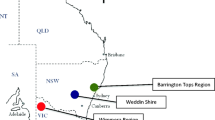Abstract
We conducted experiments designed to examine the distribution of foraging honey bees (Apis mellifera) in suburban environments with rich floras and to compare spatial patterns of foraging sites used by colonies located in the same environment. The patterns we observed in resource visitation suggest a reduced role of the recruitment system as part of the overall colony foraging strategy in habitats with abundant, small patches of flowers. We simultaneously sampled recruitment dances of bees inside observation hives in two colonies over 4 days in Miami, Florida (1989) and from two other colonies over five days in Riverside, California (1991). Information encoded in the dance was used to determine the distance and direction that bees flew from the hive for pollen and nectar and to construct foraging maps for each colony. The foraging maps showed that bees from the two colonies in each location usually foraged at different sites, but occasionally they visited the same patches of flowers. Each colony shifted foraging effort among sites on different days. In both locations, the mean flight distances differed between colonies and among days within colonies. The flight distances observed in our study are generally shorter than those reported in a similar study conducted in a temperate deciduous forest where resources were less dense and floral patches were smaller.
Similar content being viewed by others
References
Free JB (1970) Insect pollination of crops. Academic Press, New York
Frisch K von (1967) Dance language and orientation of bees. Belknap Press, Cambridge, Massachusetts
Michener CD (1974) The social behavior of the bees. Belknap Press, Cambridge, Massachusetts
Page RE, Robinson GE (1991) The genetics of division of labour in honey bee colonies. Adv Insect Physiol 23:117–169
Schneider SS (1989) Spatial foraging patterns of the African bee, Apis mellifera scutellata. J Insect Behav 2:505–521
Seeley TD (1985) Honeybee ecology: a study of adaptation in social life. Princeton University Press, Princeton
Seeley TD (1986) Social foraging by honey bees: how colonies allocate foragers among patches of flowers. Behav Ecol Sociobiol 19:343–354
Seeley, TD (1988) The effectiveness of information collection about food sources by honeybee colonies. Anim Behav 35:1572–1575
Seeley TD, Visscher PK (1988) Assessing the benefits of cooperation in honeybee foraging: search costs, forage quality, and competitive ability. Behav Ecol Sociobiol 22:229–237
Seeley TD, Camazine S, Sneyd S (1991) Collective decision-making in honey bees: how colonies choose among nectar sources. Behav Ecol Sociobiol 28:277–290
Visscher PK, Seeley TD (1982) Foraging strategy of honeybee colonies in a temperate deciduous forest. Ecology 63:1790–1801
Author information
Authors and Affiliations
Additional information
Communicated by R.F.A. Moritz
Rights and permissions
About this article
Cite this article
Waddington, K.D., Herbert, T.J., Visscher, P.K. et al. Comparisons of forager distributions from matched honey bee colonies in suburban environments. Behav Ecol Sociobiol 35, 423–429 (1994). https://doi.org/10.1007/BF00165845
Received:
Accepted:
Issue Date:
DOI: https://doi.org/10.1007/BF00165845




